Thanks to Space.com and the Tech Media Network for sharing this great graphic showing NASA’s “new” MPCV and how it compares with other human spaceflight vehicles.
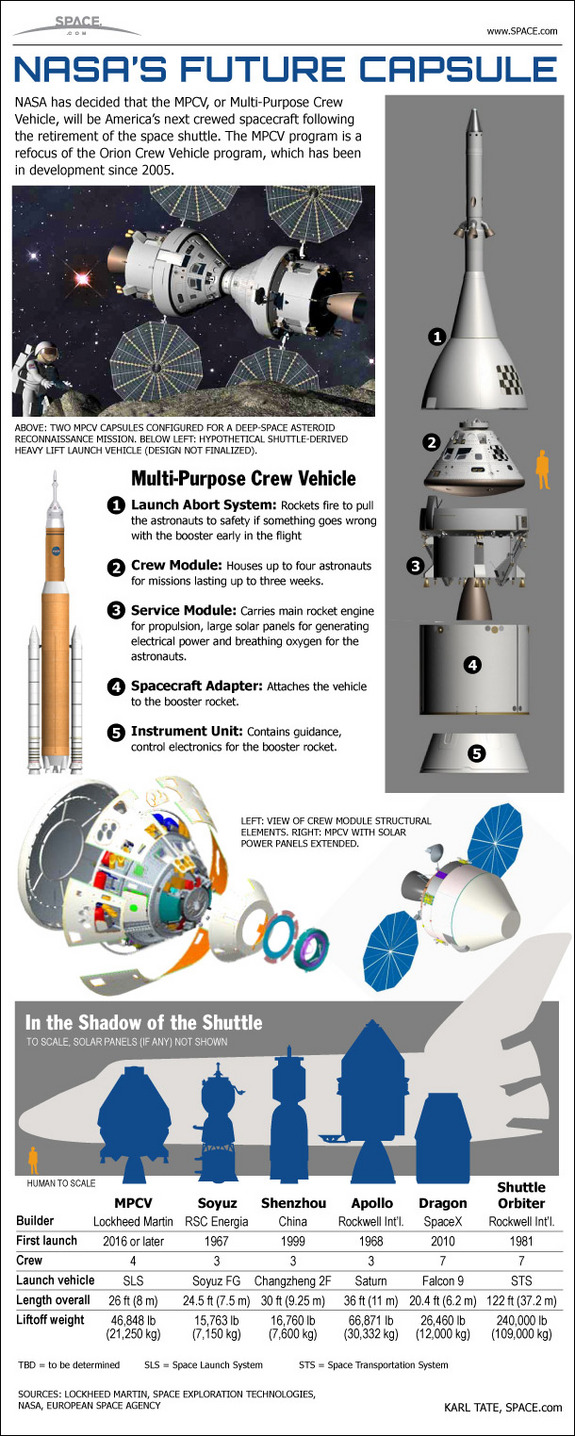
Source SPACE.com:

Space and astronomy news
Thanks to Space.com and the Tech Media Network for sharing this great graphic showing NASA’s “new” MPCV and how it compares with other human spaceflight vehicles.

Source SPACE.com:
[/caption]
Dude! This awesome image looks like a psychedelic 1970’s flashback. But is is actually a droplet of fuel burning in space, on board the International Space Station. NASA explains that because of the absence of gravity, fuels burning in space behave very differently than they do on Earth. The Flame Extinguishing Experiment on board the ISS is examining the combustion of such liquid fuel droplets, and in this image, a 3-millimeter diameter droplet of heptane fuel burns in microgravity, producing soot. When a bright, uniform backlight is placed behind the droplet and flame and recorded by a video camera, the soot appears as a dark cloud. Image processing techniques can then quantify the soot concentration at each point in the image.
NASA explains:
This colorized gray-scale image is a composite of the individual video frames of the backlit fuel droplet. The bright yellow structure in the middle is the path of the droplet, which becomes smaller as it burns. Initial soot structures (in green) tend to form near the liquid fuel. These come together into larger and larger particles which ultimately spiral out of the flame zone in long, twisting streamers.
Far out!
Source: NASA Image of the Day
[/caption]
Some sixteen decades ago, Lord Rosse was the first to point out spiral structure in distant “nebula”… and today astrophysicists Thomas Dame and Patrick Thaddeus are discovering it closer to home. Our Milky Way Galaxy was believed to only have six spiral arms, but their research has revealed an outer extension of the Scutum-Centaurus arm from the inner galaxy.
“We have identified a spiral arm lying beyond the Outer Arm in the first Galactic quadrant ~15 kpc from the Galactic center.” says Dame and Thaddeus. “One of the detections was fully mapped to reveal a large molecular cloud with a radius of 47 pc and a molecular mass of ~50,000 M. At a mean distance of 21 kpc, the molecular gas in this arm is the most distant yet detected in the Milky Way. The new arm appears to be the continuation of the Scutum–Centaurus Arm in the outer Galaxy, as a symmetric counterpart of the nearby Perseus Arm.”
Over the last 50 years, many models of our galaxy have been proposed – revealing a pleasing, duo-symmetry. However, finding evidence to prove these theories has been a bit more elusive. Since we cannot observe ourselves, seeing spiral structure on the far side of the galaxy is problematic – hidden by near-side emission at the same velocity. But these researchers didn’t stop. The new arm was found as a result of attempts to follow the Sct–Cen Arm past its tangent.
“The new arm was largely overlooked in existing 21 cm surveys probably because it lies mainly out of the Galactic plane, its Galactic latitude steadily increasing with longitude as it follows the warp in the distant outer Galaxy.” says Dame. “In the first quadrant the only prominent HI spiral feature in the outer Galaxy is the well-known Outer Arm, a feature also well traced by CO. However, at 3 degrees above the plane one sees instead the new arm as a prominent linear feature running roughly parallel to the locus of the Outer Arm but shifted to more negative velocities.”
Is our smoothly constructed galaxy indeed a mirror image of itself? This new evidence suggests the Scutum-Centaurus arm embraces the entire Milky Way – forming a symmetrical, star-forming counterpart to the galaxy’s other arm, Perseus. “Confirmation of the present feature as the ”Outer Sct-Cen Arm” will require a great deal of new data from several telescopes and much observing time over an extended period.” says Thaddeus. “Key steps toward confirming the proposal include, as mentioned, tracking Sct–Cen in the fourth quadrant and, even harder, tracking the Perseus Arm from the point where it passes inside the solar circle near longitude 50 degrees to its putative origin at the far end of the bar.”
Mapping the findings of galactic data on atomic hydrogen gas isn’t going to happen overnight… and even more discoveries and clarifications could be revealed in the future. “The Galactic symmetry suggested by the present work and clearly demonstrated by the identification of the Far 3-kpc Arm a few years ago, coupled with evidence for a global two-armed spiral pattern in the old stars, and, indeed, with the discovery of the bar itself, all hint at Galactic spiral structure that is both simpler and more amenable to study than had long been assumed. As emphasized here, much work remains, but aided by greatly improved distances from forthcoming astrometric surveys, a reasonably complete picture of our Galaxy’s spiral pattern may be achieved over the next decade.”
50 years ago today, US President John F. Kennedy addressed a joint session of Congress to ask for support for the goal to “commit…before this decade is out, to landing a man on the Moon and returning him safely to the Earth.” Kennedy urged Congress to appropriate the necessary funds, which eventually was one of the largest financial expenditure of any nation in peacetime. Just 2 1/2 years after giving this speech, Kennedy was assassinated in Dallas on Nov. 22, 1963. And in just over eight years after the speech, on July 20, 1969, NASA’s Apollo 11 mission would successfully fulfill Kennedy’s vision by landing the first humans on the moon.
Below is the transcript of the entire section on space:
Continue reading ““I believe this nation should commit itself…” Kennedy’s Moon Shot Speech to Congress”
[/caption]
Not since the work of Fritz Zwicky has the astronomy world been so excited about the missing mass of the Universe. His evidence came from the orbital velocities of galaxies in clusters, rotational speeds, and gravitational lensing of background objects. Now there’s even more evidence that Zwicky was right as Australian student – Amelia Fraser-McKelvie – made another breakthrough in the world of astrophysics.
Working with a team at the Monash School of Physics, the 22-year-old undergraduate Aerospace Engineering/Science student conducted a targeted X-ray search for the hidden matter and within just three months made a very exciting discovery. Astrophysicists predicted the mass would be low in density, but high in temperature – approximately one million degrees Celsius. According to theory, the matter should have been observable at X-ray wavelengths and Amelia Fraser-McKelvie’s discovery has proved the prediction to be correct.
Dr Kevin Pimbblet from the School of Astrophysics explains: “It was thought from a theoretical viewpoint that there should be about double the amount of matter in the local Universe compared to what was observed. It was predicted that the majority of this missing mass should be located in large-scale cosmic structures called filaments – a bit like thick shoelaces.”
Up until this point in time, theories were based solely on numerical models, so Fraser-McKelvie’s observations represent a true break-through in determining just how much of this mass is caught in filamentary structure. “Most of the baryons in the Universe are thought to be contained within filaments of galaxies, but as yet, no single study has published the observed properties of a large sample of known filaments to determine typical physical characteristics such as temperature and electron density.” says Amelia. “We examine if a filament’s membership to a supercluster leads to an enhanced electron density as reported by Kull & Bohringer (1999). We suggest it remains unclear if supercluster membership causes such an enhancement.”
Still a year away from undertaking her Honors year (which she will complete under the supervision of Dr Pimbblet), Ms Fraser-McKelvie is being hailed as one of Australia’s most exciting young students… and we can see why!

[/caption]
In the wee hours of May 25, 2011 the scientists and engineers of the Mars Exploration Rover team will send the last command in attempt to contact the Spirit rover. Over the past year, they have sent over 1,200 commands and haven’t heard anything in reply from the stuck and likely frozen rover. “We have exhausted all the likely scenarios for contacting Spirit, and the likelihood of success is now practically zero,” said John Callas, Project Manager for the Mars Exploration Rover mission. “And at this point, the season is declining and we couldn’t do any of the planned science objectives even if we heard from her now. The Deep Space Network will occasionally listen for Spirit when resources permit, but we have decided not to do anything past the last commands that will done tonight.”
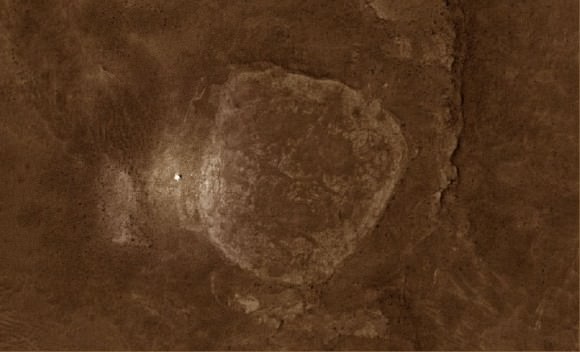
Spirit, the plucky rover that landed on Mars on January 3, 2004, overcame many difficulties and endured waaay past her 90-day warranty. For nearly six years, she traveled long distances, climbed hills — something the rovers weren’t really designed to do — she roved and stopped at interesting rocks along the way, all the while beaming back the information she garnered, enlightening us all about the nature of Mars, past and present.
Spirit became embedded in soft Martian soil in May of 2009 and that was the beginning of the end. The team spent months planning for her extrication, and then months again attempting to drive her out, but they ran out of time and power in the approaching Martian winter. The team was unable to put the rover in a favorable position to catch rays of sunlight on her solar panels, and after another freezing, grueling winter, Spirit has now likely succumbed to the harsh environment on Mars.
“We drove it, literally, until its wheels came off and at the beginning of the mission, we never expected that would be the way this project would end up,” said Dave Lavery, MER program director at NASA Headquarters.
The last commands will be sent early on May 25, 0700 UTC, which is just after midnight at JPL in Pasadena, California.
So, this is it. This is end of the Spirit rover mission.
“We always knew we would get to this point,” Callas said during a teleconference with the press, “and really, that’s what we wanted to do, to utilize these rovers as much as possible and wear them out. We are here today because we really wore Spirit out. If on sol 90 (the 90th Martian day of the mission) someone would have said this was going to last another 6 years, we just wouldn’t have believed it.”
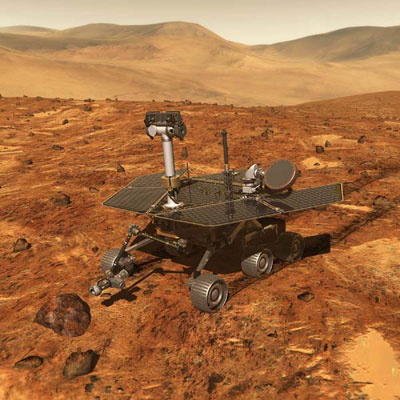
Asked what Spirit’s lasting legacy would be, Callas told Universe Today, “In addition to the great exploration and scientific discoveries, I think the great intangible that goes with Spirit is that she has made Mars a familiar place for us. It is no longer a mysterious location. For six years we’ve had people who go to work on Mars every day, via the rovers.”
The original plan was to try and contact Spirit once a week through the end of 2011, but the team has come to realize that the probability of success was practically zero and they would be wasting valuable resources, both human time and listening resources from the DSN. So the decision was made to end the attempts to contact Spirit.
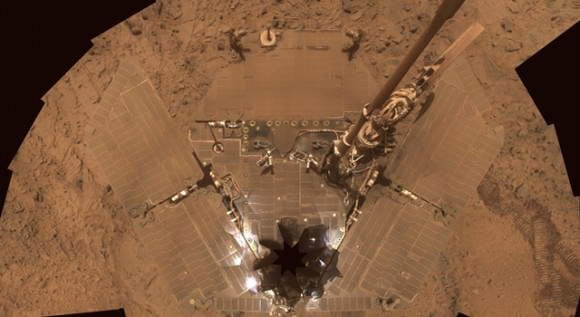
One of the challenges that Spirit faced is that it always had dust on the solar arrays, Callas said, even during the first winter on the Columbia Hills. After a timely dust cleaning event by a dust devil, the team was able tilt Spirit to gather sunshine and she survived. The second winter she achieved a 10% tilt and survived; the third winter, the team was able to find a 30% tilt – again she survived. But the 4th winter, there just wasn’t the right geography in the sand pits of Troy that would enable Spirit to survive after it became embedded.
What is the mood of the rover team? “We all are taking realistic look, as this mission was originally supposed to last only 90 sols, and we thought if we were extraordinarily lucky we’d get twice that much time and that the first Martian winter would be the end of the mission” said Lavery. “Realistically, in every possible definition of the word, we looking at this as a massive success in terms of longevity and the massive science return we got out of the project. As this particular chapter of Spirit’s mission comes to a close, this is very much a celebration of the accomplishments of the rover and the success it has had, and looking forward to the next steps of Mars exploration.”
Lavery added that the teams are not looking at this as a funeral, but more like an Irish wake. “I’m sure we’ll be telling stories of when Spirit was a wee little rover,” he said. There will be a science team meeting in July and they will use that opportunity to bring together all who were involved in development and science planning to come together and have some sort of event at that time.
“They are cutest darn things out in the solar system,” Callas said. “Yes, we are attached to these beautiful, accomplished little proxies out on the surface of Mars. We have sadness that we have to say goodbye to Spirit, but we have to remember the great accomplishments and the blessings we’ve received for having this rover operate for all this time, for over six years.”

Spirit made many discoveries – finding carbonates which told scientists much about the past habitability of Mars and that it likely had a thicker atmosphere at one point. Then, even failure brought discovery, as the malfunction of the right front wheel in 2004 meant the team had to relearn to drive the rover, driving it backwards, dragging the wheel behind. This churned up the top soil and revealed what was under the surface: amorphous silica, which is evidence for an ancient hydrothermal system on Mars, which means not only water but an energy source that could have been driving a type of ecosystem in one particular location on Mars.
“There’s an enormous amount that can and still will be written about Spirit and the discoveries she’s made. The science team will be writing papers for a long while,” said Lavery. “But there’s also the inspiration that the rover provided to the team and really to the entire country that we were able to put together a project that went to another planet and survived well past its designed lifetime. The sense of wonder and sense of accomplishments go well beyond the mission itself.”
Yes, we knew this day was coming. Spirit roved her way into our hearts and into the science books. She will not be forgotten.
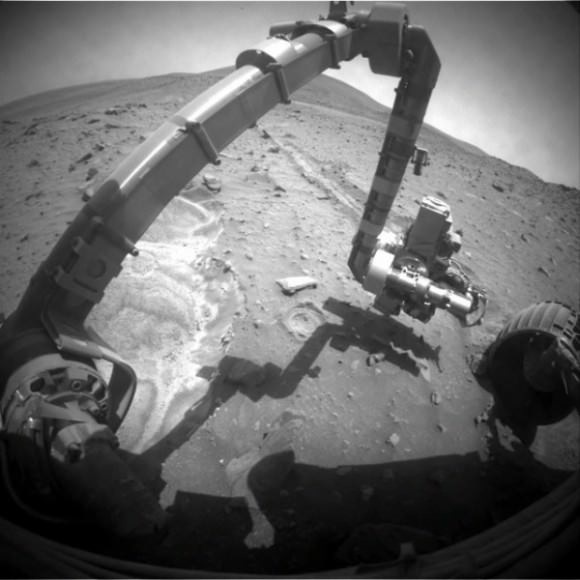
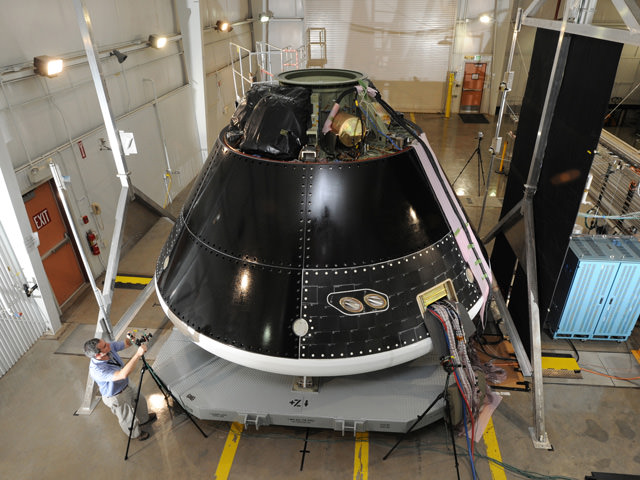
[/caption]
NASA has made a decision on their next crew vehicle, and now have plans to develop a “new” spacecraft called the Multi-Purpose Crew Vehicle (MPCV). NASA Administrator Charles Bolden announced today that the system will be based on designs originally planned for the Orion Crew Exploration Vehicle which was being built to return humans to the Moon. This decision shouldn’t come as a surprise, and it is not a huge leap or a big change for NASA — the Orion crew vehicle has been in continued development by Lockheed Martin and the company was already making changes in the vehicle for a proposed asteroid mission.
“We are committed to human exploration beyond low-Earth orbit and look forward to developing the next generation of systems to take us there,” Bolden said. “The NASA Authorization Act lays out a clear path forward for us by handing off transportation to the International Space Station to our private sector partners, so we can focus on deep space exploration. As we aggressively continue our work on a heavy lift launch vehicle, we are moving forward with an existing contract to keep development of our new crew vehicle on track.”
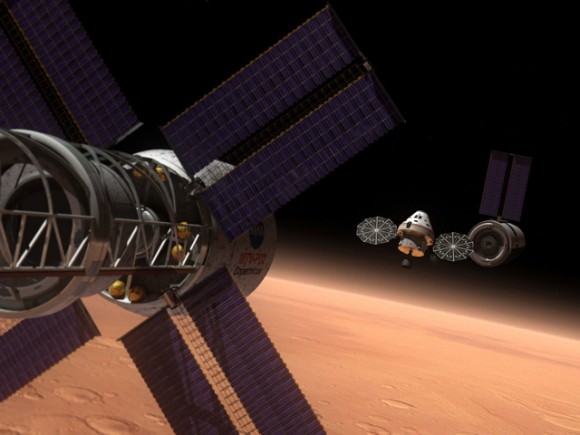
NASA said that Lockheed Martin will continue work on development of the MPCV, since they already have a test article built of the Orion. The spacecraft will carry four astronauts for 21-day missions and be able to land in the Pacific Ocean off the California coast. The spacecraft will have a pressurized volume of 690 cubic feet, with 316 cubic feet of habitable space.
It will serve as the primary crew vehicle for missions beyond low Earth orbit and be capable of conducting regular in-space operations (rendezvous, docking, extravehicular activity) in conjunction with payloads delivered by a launch system for missions beyond LEO. The MPCV could also be a backup system for ISS cargo and crew delivery.
A 21-day mission might get astronauts to a nearby asteroid, but there would not be enough time for a longer-duration, far-away asteroid mission and certainly not to Mars. It would get you to the Moon, allowing astronauts to stay a couple weeks and then return home, which was what Constellation was going to do in its first stages.
UPDATE: During a press conference today, Doug Cooke, associate administrator for NASA’s Exploration Systems Mission Directorate said that the approach on the MPCV vehicle is that it primarily will be for launch and entry with in-space capabilities for only certain periods of time. “For long term missions, we would assume that we have an in-space habitation in a larger compartment or module since the crew would need more space for longer periods of time. So whether they are going to lunar orbit or near earth asteroids, this vehicle would be maintained in a dormant mode while the crew would be in another volume that would be capable of longer term use, but this vehicle would be used as launching to a larger volume, or for reentry.”
The Orion vehicle at one time had been pegged to be a rescue vehicle for the International Space Station. Cooke said that this new vehicle is not being designed for that, but another vehicle could be in designed for that.
One big selling point is that the new MPCV is designed to be 10 times safer during ascent and entry than its predecessor, the space shuttle.
“This selection does not indicate a business as usual mentality for NASA programs,” said Cooke, “The Orion government and industry team has shown exceptional creativity in finding ways to keep costs down through management techniques, technical solutions and innovation.”
Now, NASA just needs a rocket that can take the MPCV somewhere — as well as a new name for the MPCV. (Cooke said a name for the vehicle hasn’t been their top priority.) Cooke said they hope to make an announcement in July about the launch system that will be used.
The current rumor is that the new Congressional-mandated launched system will be based on the Ares 5, the heavy-lifter NASA began designing in 2006 for manned Moon missions which was canceled by President Obama along with Orion…
This video from NOAA’s GOES geostationary satellite shows the development of the supercell storm that produced the devastating tornado that struck Joplin, Missouri. Here you can see the storm develop over Missouri, Oklahoma, Kansas state lines on May 22, 2011 between 12:44pm to 7:15pm CDT. This was part of the great wave of severe storms that swept across the central United States, with tornado warnings from Minneapolis to Dallas. The most damaging storm struck Joplin at 5:30 pm local time (2230 UTC), killing at least 116 people.
Below is imagery from the Tropical Rainfall Measuring Mission satellite (TRMM).
Continue reading “Joplin, Missouri Tornado Seen From Space”
[/caption]
Of the 1235 planetary candidates that NASA’s Kepler space telescope has found so far, 408 reside in multiple-planet systems – a growing trend that indicates planets do, in fact, like company.
The systems observed also seem to behave quite differently than our own solar system. In particular many are flatter than ours; that is, the planets orbit their stars in more or less the same exact plane. This, of course, is what allows Kepler to see them in the first place… the planets have to transit their stars perpendicular to Kepler’s point of view in order for it to detect the oh-so-subtle change in brightness that indicates the likely presence of a planet. In our solar system there’s a variation in the orbital plane of some planets up to 7º – enough of a difference that an alien Kepler-esque telescope might very well not be able to spot all eight planets.
The reason for this relative placidity in exoplanet orbits may be due to the lack of gas giants like Jupiter in these systems. So far, all the multiple-planet systems found have planets smaller than Neptune. Without the massive gravitational influence of a Jupiter-sized world to shake things up, these exosystems likely experience a much calmer environment – gravitationally speaking, of course.
“Most likely, if our solar system didn’t have large planets like Jupiter and Saturn to have stirred things up with their gravitational disturbances, it would be just as flat. Systems with smaller planets probably had a much more sedate history.”
– David Latham, Harvard-Smithsonian Center for Astrophysics, Cambridge, MA
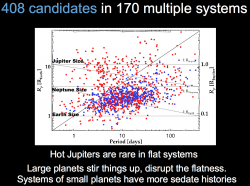
Systems containing large gas giants have also been found but they are not as flat as those without, and many smaller worlds are indeed out there… “probably including a lot of them comparable in size to Earth,” said planet-hunter Geoff Marcy of the University of California, Berkeley.
While multiple-planet systems were expected, the scientists on the Kepler team were surprised by the amount that have been discovered.
“We didn’t anticipate that we would find so many multiple-transit systems. We thought we might see two or three. Instead, we found more than 100,” said Latham.
A total of 171 multiple-planet systems have been found so far… with many more to come, no doubt!
Announced yesterday at the American Astronomical Society conference in Boston, these findings are the result of only the first four months of Kepler’s observations. There will be another news release next summer but in the meantime the team wants time to extensively research the data.
“We don’t want to get premature information out. There’s still a lot of analysis that needs to be done.”
– Kepler principal investigator William Borucki
Read more on the Kepler mission site, or on Science NOW.
[/caption]
We are all just star stuff… But when it comes to the elements produced by a star, it just doesn’t get any heavier than iron. So how do more exotic elements come into existence? Try the Great Cosmic Recycler – supernova. Its energy disperses newly synthesized materials right into the interstellar neighborhood where an enriched generation of stars begin life again.
The beautiful Carina Nebula may very well be a literal supernova factory. Encompassing a large field of 1.4 square degrees, Chandra made of a mosaic of 22 individual pointings. In total, the image represents 1.2 million seconds – or nearly two weeks – of Chandra observing time. In addition, multi-wavelength data, such as infrared observations from the Spitzer Space Telescope and the Very Large Telescope (VLT), were then added to the mix to reveal that the supernova process has already begun. Clues, such as the lack of bright x-ray sources from Trumpler 15, suggest its massive stars have already been destroyed. In addition, six candidate neutron stars – instead of just one – provide additional evidence that supernova activity is gearing up in Carina.
But stellar destruction isn’t the only evidence Chandra has found. A new population of young massive stars has also been detected… potentially doubling the number of known young, massive stars which are usually destined to be destroyed later in supernova explosions. In the composite image, they appear as bright X-ray sources scattered across the x-ray emission like freckles on a child’s face. But what really holds our interest is the infamous Eta Carinae – a massive, unstable star on the brink of extinction.
Thanks to this latest research, we now know it’s not alone…